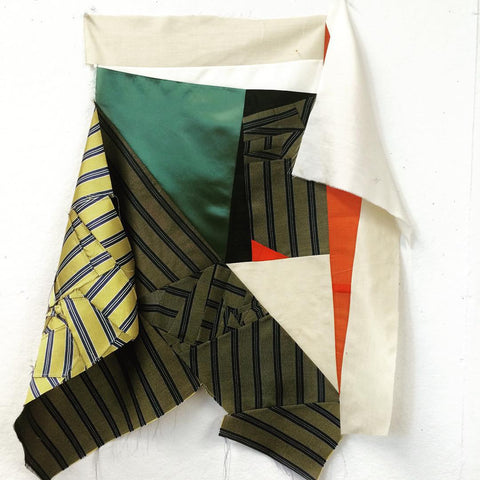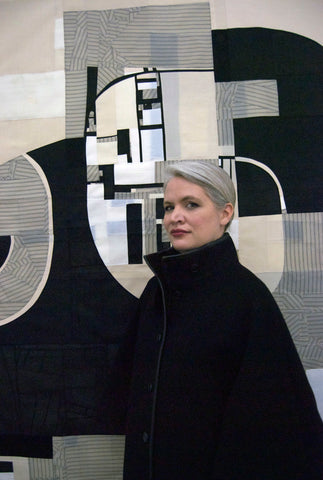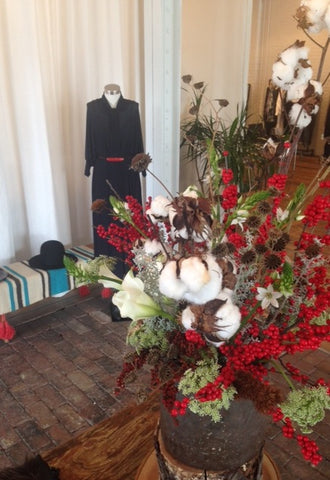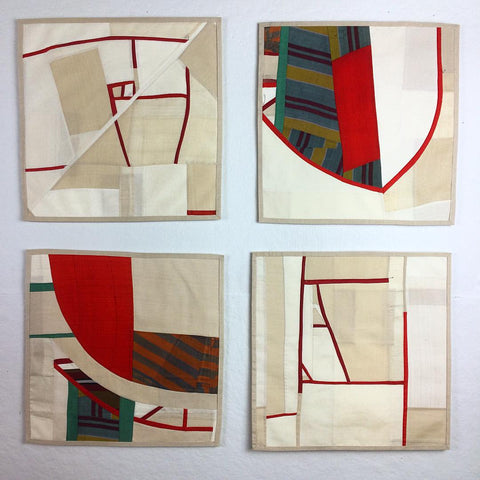debra smith :: textile artist
by Susan Cannon
Anyone who knows Debra Smith would agree that the artist possesses a notably buoyant, uplifting personality, and that her magical energy lingers whenever she leaves a room.
This energy too, contributes to the artist's prolific nature in creating a large body of abstract textile artworks. She skillfully arranges and manipulates kimono fabric, contemporary Japanese materials and vintage men's suit lining and tie silks—resulting in graphic, textural, expressionistic studies.
Smith is also well known for her contemporary hand-woven Sakiori scarves, which she began making 20 years ago, while studying at KCAI.
Of late, the artist is also making use of her keen eye for color, composition and texture through floral design, contributing as the resident florist for Finefolk Shop + Studio.
Debra Smith with her works during her solo exhibition Shifting Territory at the Haw Contemporary, 2014, wearing clothing from Finefolk.
I Too, Am The Shit 2014, pieced vintage kimono silk and men's suit lining, 44 x 78 in.
Shifting Territory 2014, pieced vintage kimono silk, 85 x 66 in.
Edge Of Thought series 2014, pieced vintage kimono silk and men's suit lining, 30 x 36 in.
FF- Debra, you have deep knowledge for textiles, process and craft. We understand that took root earlier in your life, being surrounded by artisans in your family.
D- Actually my fiber heritage is very strong. Both my mother and my grandmother are textile artists. I grew up in a small town (Hannibal Missouri) where my mother was the chair of the Arts Council. It was very common to have Raku fire pits in the backyard or weekend cyanotype workshops happening as a kid. My mother experimented with Navajo and tapestry weaving. As she learned about shearing sheep, carding wool and natural dyes my brother and I were along for the ride. My grandmother was a painter, quilter and a weaver, as well. She focused more on traditional and experimental rug weaving. The older I get the more I understand just how extraordinary this creative childhood was.
FF- You ventured abroad to study at the Italian Academy of Fashion & Design—Lorenzo de Medici in Florence, before receiving a BFA in Fiber Arts from the Kansas City Art Institute, and an Associate Degree in Applied Science from FIT in New York City. Tell us about your educational experiences.
D- KCAI had a study abroad program and I chose to jump headfirst into a country where I didn't speak the language. Little did I know that there would be no Italian students in my classes, and that both of my roommates would be from New York City, with no real desire to learn Italian. My dear friend Paul Soodsma was in my pattern-drafting class. An example of our fun moments and challenges was when we listened to a two hour lecture of instruction in Italian and had to execute a task we didn't understand, so Paul and I drank shot after shot of espresso to try and stay awake, only to doze off to the sing-song sea of different languages. Upon waking, some Chinese students did their best to help us complete our project, thank God. In my textile class I was dipping dried apricots in shellac, making garments on the dress form and weaving fabrics out of dyed and torn silks based on those textures. Not sure if it's safe to say that my foray into pattern drafting was lost in translation, but definitely my interest in textiles and fabric manipulation grew out of this time of experimentation.
While at the Kansas City Art Institute I enjoyed my first opportunity to explore all mediums. KCAI has an amazing foundations program in which I could work on ceramics, photography and printmaking. But, in the end I found that I could work with all of those mediums in the fiber department.
During my senior year at KCAI, a Kansas City-based shop and design studio, Asiatica, that makes clothing out of deconstructed antique Japanese Kimono fabrics, made a donation to the fire department. I acquired much of the fabric, as I was totally mesmerized by the bits and pieces I found from the incredible kimonos. I decided to piece them together and weave a few Sakiori scarves for the end-of- semester show. Without my knowledge, one of the Asiatica owners came and bought a scarf of mine, took it back to her business partner exclaiming 'I got the best thing at the show!' Elizabeth looked her square in the eye and said 'Fifi that's our fabric!' A few months later I had the privilege to be working there. With Elizabeth Wilson's Asian art background and expertise, and Fifi White's knowledge of textiles, I could not have found myself in a better place to continue learning about things of such beauty.
FF- Tell us about FIT and New York.
Due to an unexpected series of life circumstances—one of the biggest being hit by a car while on my bicycle in Brooklyn and being in a wheelchair for six months—I made the decision that I probably wouldn't have made if this incident had not occurred. I decided in 2001 to do an accelerated program at FIT in the study of accessories. I learned a lot about the quality of materials, superior design and construction.
Pretty much the entire time that I was in New York I was self-employed. Living in an old Irish dance hall with a studio a few blocks away on the ground floor of an old pencil factory in Greenpoint, Brooklyn, I continued making Sakiori scarves out of antique Japanese kimono fabric to pay most of the bills, and continued to build my art practice slowly but surely in the few and far moments in between weaving. A lot of the men with giant woodworking studios in the same building would stop by my open door and say, "Hey little lady, is this your hobby?" as they looked around the riot of color in my studio. Slowly, one by one they all moved out and my 'little hobby' and perseverance outlasted them.

Smith in one of her Sakiori scarves.
FF- Your Sakiori scarves are well known and widely sold. Tell us about the creating process.
D- I have been weaving them for over 20 years, and not for one moment have I ever been bored or out of ideas. My studio is full of tiny little bundles of beautiful fabric divided by color and structure. I can never see all of the fabric at once, so there are always new discoveries of color combinations to be made.
Each scarf is pieced silk fabric for the warp and the weft. The style of weave is plain weave, created on a four-harness loom. Each scarf takes about five hours, with the weaving being the fastest part - only about an hour. It's all the hand work that goes into each scarf before and after it is woven on the loom that takes so much time.
FF- You've had a busy year. Please fill us in.
DS- I kicked off my year by participating in the Rijswijk Textile Biennial at the Museum Rijswijk , which was a huge honor to be invited to. This prompted me to travel through the Netherlands, taking in the famous cheese festivals and Dutch flower and flea markets, enjoying Trappist beer all the way!
I was then approached Ky Anderson to be part of a group series show in New York called DUSK/Embossed, where artists' mixed media works were employed on Anderson's uniquely embossed paper. This show subsequently went on exhibition at Look&Listen in Saint Chamas, France.
My fall was then filled with creating a series of work, Shifting Meditation, for the Kathyn Markel Fine Arts Humble Iterations exhibition in New York. That show traveled to Art Basel in Miami, and my work garnered press in Hyperallergic - http://hyperallergic.com/258085/sussing-out-the-good-stuff-at-art-on-paper-and-miami-project/
I then curated Women's Work: Points of View, an exhibit of my newest works, paired with vintage American quilts collected by Elizabeth Wilson of Asiatica, at the newly restored Volland Store—an art gallery/community center in Alma, Kansas in the Flint Hills. The exhibit culminates this weekend with Holiday Mercantile: Rural | Urban, Saturday, December 12, and Sunday, December 13, 11am-7pm.
Smith's creativity with flora at Finefolk.

Smith in her art studio.

A work in progress.
Shifting Meditation series currently on view at Kathryn Markel Fine Arts in New York from Dec. 3 through Dec. 23, and were exhibited in Art On Paper at Art Basel Miami.
Asked about her faves in Finefolk right now, Smith expresses guilty desire for pieces from Tess Giberson and Ryan Roche. "As a 'fiber girl' you can't help but fall in love with these textures."
Tess Giberson Fringe Coat.
Ryan Roche Shag Cardigan.
A Megan Park 20s inspired dress is also a fave pick for the holidays.

An autumnal arrangement by Debra Smith in Finefolk.

Textile works from Smith's Observing Presence series, recently published in New American Paintings.
Debra Smith is represented by Haw Contemporary. http://www.hawcontemporary.com/
Photography of Smith at Haw Contemporary by Leslie Fraley.











